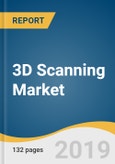The global 3D scanning market size is estimated to reach USD 8.04 billion by 2025, according to this study. It is anticipated to expand at a CAGR of 8.4% from 2019 to 2025. Increasing R&D spending and technological advancements are anticipated to drive the growth. The emergence of structured light technology, counter to the customary laser dot or laser line technology, is also estimated to fuel the growth.
The convergence of these technologies may provide enhanced interactive and immersive experiences. The increasing number of advanced wearable devices, complemented by portable and sophisticated 3D scanners, could potentially make the human-techno interaction more immersive, realistic, and adjunct with fabrication practices. The incipient trends, such as mixed reality, Internet of Things (IoT), and rising conjunction between a wearable device in automotive fabrication and aerospace -designing are anticipated to drive the market growth.
3D scanning technology is expected to significantly transform the healthcare sector, owing to the increasing number of applications. The technology helps the healthcare organizations improvise their existing processes precisely and efficiently. The integration of 3D scanning and Mixed Reality (MR) technology in the medical field involves live interactive imaging for assisting medical students and physicians in their medical practice. For instance, researchers are able to use 3D scanning and MR technology to help doctors conduct surgeries more effectively and teach complex subjects to medical students. 3D scanning can help direct neurosurgery navigation for minimally invasive interventions in simplified forms.
On the basis of product type, the 3D scanning market can be categorized into laser scanner, structure light scanner, optical scanner, and others. Optical scanners have been evolving gradually whereas the laser scanners have received acceptance owing to the launch of various innovative portable scanners. Increasing demand in industrial manufacturing, automotive designing is expected contribute to the market growth. A 3D scanner is used to capture straightforward and rigid dimensions of complex buildings and objects by deploying a laser medium. The modern-day intuitive touch-screen laser scanning models deliver increased clarity thereby conveying an astounding user experience.
Further key findings from the report suggest:
This product will be delivered within 1-3 business days.
The convergence of these technologies may provide enhanced interactive and immersive experiences. The increasing number of advanced wearable devices, complemented by portable and sophisticated 3D scanners, could potentially make the human-techno interaction more immersive, realistic, and adjunct with fabrication practices. The incipient trends, such as mixed reality, Internet of Things (IoT), and rising conjunction between a wearable device in automotive fabrication and aerospace -designing are anticipated to drive the market growth.
3D scanning technology is expected to significantly transform the healthcare sector, owing to the increasing number of applications. The technology helps the healthcare organizations improvise their existing processes precisely and efficiently. The integration of 3D scanning and Mixed Reality (MR) technology in the medical field involves live interactive imaging for assisting medical students and physicians in their medical practice. For instance, researchers are able to use 3D scanning and MR technology to help doctors conduct surgeries more effectively and teach complex subjects to medical students. 3D scanning can help direct neurosurgery navigation for minimally invasive interventions in simplified forms.
On the basis of product type, the 3D scanning market can be categorized into laser scanner, structure light scanner, optical scanner, and others. Optical scanners have been evolving gradually whereas the laser scanners have received acceptance owing to the launch of various innovative portable scanners. Increasing demand in industrial manufacturing, automotive designing is expected contribute to the market growth. A 3D scanner is used to capture straightforward and rigid dimensions of complex buildings and objects by deploying a laser medium. The modern-day intuitive touch-screen laser scanning models deliver increased clarity thereby conveying an astounding user experience.
Further key findings from the report suggest:
- Adoption of 3D scanning technology in the Architecture, Engineering, and Construction (AEC) sectors is at a nascent stage. As the equipment and service costs of 3D scanners decrease, the opportunity for leveraging 3D scanning across the AEC sector is expected to become more tangible
- The technology offers several potential benefits for project development, operations, and maintenance of existing assets, which are not completely realized by the customers
- Asia Pacific is anticipated to witness immense growth opportunities from automotive and architectural sectors over the forecast period
- Key players in the 3D scanning market include Nikon Metrology NV, Autodesk, Inc., Hexagon AB, FARO Technologies, David Vision Systems GmbH, Basis Software, Inc., Artec 3D, Fuel3D Technologies Limited, Creaform, Inc., and GOM GmbH
This product will be delivered within 1-3 business days.
Table of Contents
Chapter1 Methodology and Scope
Chapter 2 Executive Summary
Chapter 3 Industry Outlook
Chapter 4 3D Scanning: Product Type Estimates and Trend Analysis
Chapter 5 3D Scanning: Range Estimates and Trend Analysis
Chapter 6 3D Scanning: End-user Industry Estimates and Trend Analysis
Chapter 7 3D Scanning: Component Estimates and Trend Analysis
Chapter 8 3D Scanning: Type Estimates and Trend Analysis
Chapter 9 3D Scanning: Application Estimates and Trend Analysis
Chapter 10 3D Scanning: Regional Estimates & Trend Analysis
Chapter 11 Competitive Landscape
Companies Mentioned
- Nikon Metrology NV
- Autodesk, Inc.
- Hexagon AB
- FARO Technologies
- David Vision Systems GmbH
- Basis Software, Inc.
- Artec 3D
- Fuel3D Technologies Limited
- Creaform, Inc.
- GOM GmbH
Methodology

LOADING...








